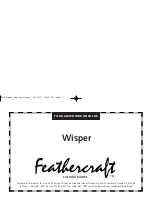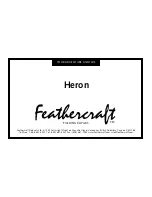
p. 16
Owners Manual
Should oxidization affect the paint work some
maintenance will need to be carried out to retain
the appearance of your vessel:
• Sand the affected area removing the bubbled
paint and any signs of oxidisation. Feather in
the edges of the remaining paint work.
• Clean the area of all contamination using a
prep solution.
• Mask off the areas not being repaired.
• Apply a suitable etch primer to the sanded
area and allow to dry.
• Apply the top coat to the area to be repaired
and allow to dry.
• After allowing the paint to dry, buff the area
to blend in the repair.
• Advice and materials for this type of
maintenance can be obtained from your local
dealer.
In unpainted boats most customers do not realise
this reaction is occurring because there is no paint
to bubble and flake. The reaction is shown by the
normal dull appearance unpainted boats develop
over time.
WARRANTY POLICY
Paint is warranted against defective paint or
application, NOT against the normal effect of
oxidisation around unsealed edges and fittings.
Oxidisation is normal for aluminium boats and is
only cosmetic if not caused by a dissimilar metal.
Salt and moisture reacting with the aluminium will
not affect the boat structurally.
Never use the following to clean your boat:
• Petrol
• Benzine
• Carbon tetrachloride
• Acetone
• Paint thinner
• Turpentine
• Lacquer thinner
• Nail polish remover
• Or any products containing these or similar
items.
THE HULL
Marine aluminium does not need to be painted
for protection from the elements, unless the boat
is moored permanently for long periods. It is
already highly resistant to corrosion and will not
deteriorate if simple precautions are taken.
Always wash the boat off with fresh water
after removing it from the water. This alleviates
corrosion- causing surface oils and dirt.
CLEANING UNPAINTED BOATS
The shiny finish on unpainted boats will normally
develop a surface oxidation film over time. This film
is usually dull in colour and will actually protect
the metal beneath indefinitely with nothing more
than an occasional wash. However, the bright
aluminium finish can be restored by following this
recommended procedure:
• Remove all surface dirt and oils. Note Some
washing detergents are highly alkaline or
acidic. These will remove the protective
surface oxidation film and must not be used.
• Rinse with plenty of fresh water and dry the
boat with a clean, damp chamois.
• Polish the hull surface with an abrasive
compound or automotive aluminium wheel
cleaner. Follow the directions provided in the
polish manufacturer’s instructions.
• Be aware the oxide will return, this is a natural
aluminium reaction to outdoor elements.
CLEANING PAINTED BOATS
The following soiling left on your boat may cause
corrosion, discolouration and stains - wash them
off as soon as possible:
• Seawater
• Anti-freeze from road travel.
• Soot and dust, iron powder from factories,
chemical substances such as acids, alkalis,
cola tar etc.
• Bird droppings, insect carcasses, dried old
bait, sap, fertilizers etc.
Cleaning products can be dangerous. Some
are poisonous, others can ignite or react
with a hot part of the vessel, e.g. outboard
motor. Some are dangerous if the fumes
are inhaled in an enclosed space. When
using anything to clean your boat, be sure
to read and follow the manufacturers
instructions.
ATTENTION
!









































